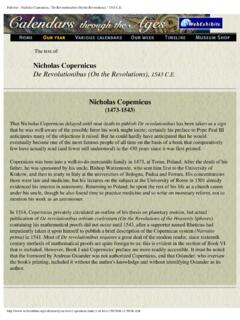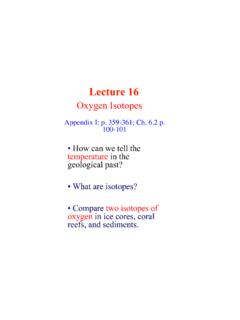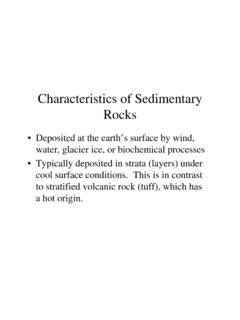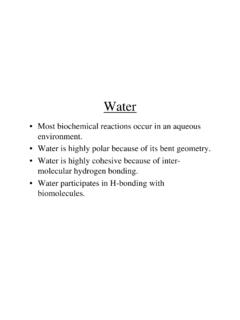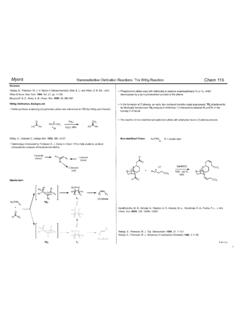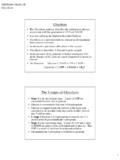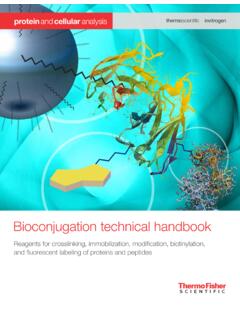Transcription of 3 CHEMICAL THERMODYNAMICS
1 1 3 CHEMICAL THERMODYNAMICS Definitions: (From Smith, 1982, and Anderson and Crerar, 1994) 1. THERMODYNAMICS : Energy differences and transfers between systems. 2. Systems: Isolated system: have walls or boundaries that are rigid, do not permit transfer of mechanical energy, perfectly insulating, and impermeable. The have a constant energy and mass content. Adiabatic systems: Perfectly insulated systems. Closed systems: have walls that allow transfer of energy in or out of the system but are impervious to matter. They contain a fixed mass and composition, but variable energy. Open Systems: have walls that allow transfer of both energy and matter to and from the system.
2 Simple Systems: Contain no interior walls. Composite system: Two or more simple systems, and thus contain internal walls. 3. Equilibrium: A system at equilibrium has none of its properties changing with time . A system at equilibrium will return to that state after being disturbed. 4. State Variables: Variables that define the state of a system. Extensive variables are proportional to the quantity of matter being considered (V, total Cp). Intensive variables are independent of quantity (concentration, viscosity, density, molar Cp) 5. Work (w): The transfer of energy from one mechanical system to another. It is always completely convertible to the lifting of a weight . The energy that flows across a system boundary in response to a force moving through a distance (such as happens when a system changes volume.)
3 6. Heat (q): The transfer of energy that results from temperature differences . The energy that flow across a system boundary in response to a temperature gradient. that part of any energy transfer that is not accounted for by mechanical work (FxD). q= U-w 7. Heat Capacity: The relation between heat transferred to a body and the change in T. 8. Enthalpy: The increase in enthalpy of a system is equal to the heat absorbed at constant pressure, assuming the system does only PV work. 9. Entropy: A measure of the loss of capacity of the system to do work. 10. ZEROTH LAW: Two bodies in thermal equilibrium with a third are in thermal equilibrium with each other (Basis of the concept of temperature) 11.
4 FIRST LAW: The alegraic sum of all energy changes in an isolated system is zero (Conservation of energy). Energy can be converted from one form to another but cannot be created or destroyed. U=q+w. This is based only on observation 12. SECOND LAW: Spontaneous changes are those which, if carried out under the proper conditions, can be made to do work. If carried out reversibly they yield a maximum amount of work. In natural processes, maximum work is never obtained. 2 Basic Principles THERMODYNAMICS is the study of energy in systems, and the distribution of energy among components. In CHEMICAL systems, it is the study of CHEMICAL potential, reaction potential, reaction direction, and reaction extent First Law of THERMODYNAMICS : dU=dq + dw where U is the internal energy, q is the heat transferred to a system from the surroundings, and w is the work done on a system by the surroundings.
5 The change in the internal energy, dE, is the sum of the heat transferred to the system, dq, and the work done on the system, dw. This is the energy conservation principle for a system (Stumm and Morgan, 1981, p. 17). For a finite change: U=q + w Work and reversible reactions .: Work is the transfer of energy from one mechanical system to another. It is always completely convertible to the lifting of a weight. Work done on a system is positive, and work done by the system as negative. An example of work by the system is the expansion of a cylinder against the atmosphere. =21vvrevPdVw For a system doing only PV work: dU = dq + dw dU = dq - PdV where PdV is the reversible expansion work done on the system by the surroundings.
6 An analog of a system doing no work would be a sled going down a hill. The reaction is spontaneous, and potential energy is eventually converted to heat due to friction (w=0, dU = dq. The reaction proceeds until the potential energy minima is reached, , the bottom of the hill. The reverse reaction is not spontaneous. An analog for a system doing work would be if one attached an object to the sled over a pulley, where the mass of the object M2 < M1, the mass of the sled and driver. As the sled goes down hill, the object is pulled upward, and work is done (dU = dq + w; w = M2gdh). As the mass of the object M2 increases, more work is accomplished, until M1 is only infinitesimally greater than M2, and the maximum amount of work can be accomplished as the sled moves infinitely slowly, and only an infinitesimal amount of energy is required to reverse the process.)
7 3 Second Law of THERMODYNAMICS The second law is concerned with entropy (S), which is that part of the total energy of the system that is not available to do useful work. Statement One: The total entropy change of the closed system is dSsys and is the sum of changes inside the system, dSint, and entropy transferred to the system from its surroundings, dSsur. dSsys= dSint + dSsur dSsur = dq/T For a reversible process or equilibrium state of the system, the second law states that the internal entropy change is zero: dSint = 0 For a spontaneous or natural process in the system dSint > 0 So for any spontaneous natural process dSsys > dq/T The internal entropy change for a closed system is zero at equilibrium and positive for a spontaneous process.
8 The heat transferred to a closed system, divided by T, is equal to or less than the entropy increase for any possible process. The entropy of an isolated system increases in any spontaneous process and attains a maximum for any reversible process. (Stumm and Morgan, p. 19). Free Energy The Gibbs Free energy is that portion of the total system energy that is available for useful work. For most cases in water chemistry, the system is closed to the addition and removal of matter, but open to the transfer of energy. The system is at constant temperature and pressure, does only PV work, with P constant, so only expansion work is done: dw=-PdV At equilibrium, and with fixed composition (no addition of material): dq = TdS(sys) 4 so dU = TdS - PdV So the internal energy is a function of entropy and volume.
9 Another expression for total system energy is Enthalpy (H): H = U + PV dH = dU + PdV When T and P are constant, we can use Gibbs expression for free energy dG = dU + PdV - TdS dG = dH - TodS Where: G = Gibbs free energy, kcal/mol T = absolute temperature, oK S = entropy, cal/oK H = enthalpy, kcal/mol This equation tells us if a reaction will happen, and in what direction. a) Enthalpy: the total energy content of acompound (dH = dU+PdV) in kJ/mol; . b) Free Energy: That part of the total energy that is available to perform "useful work", that is, other than PV work, such as electrical work, in kJ/mol. c) Entropy: the degree of disorder of a system. The product TS is that part of the free energy which is NOT available for useful work, in joules/oK.
10 Heat Capacity: Heat capacity is defined as the change in temperature of a system with a change of heat transferred to the system: CdqdTCvUTCHTVPP== = ~ Heat capacity can be measured directly by calorimetry (at constant pressure), and can provide information on enthalpy for a closed-system process. 5 Law of Mass Action: The driving force of a reaction is related to the concentrations of reactants and products. aA + bB ---> cC + dD The ratio of products to reactants is expressed by the equation: [][ ][][]CDABQ cdab= At equilibrium this ratio is equal to the equilibrium constant, K. Equilibrium For a closed system at constant pressure and constant temperature, the criterion for equilibrium is that the total free energy of the system (GT) is a minimum.



